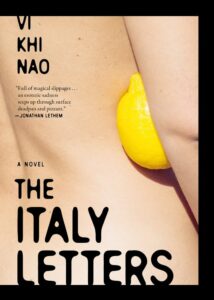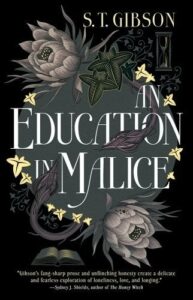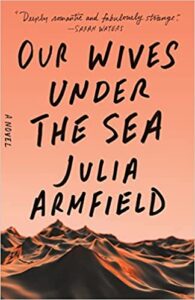Buy this from Bookshop.org to support local bookstores and the Lesbrary!
The Italy Letters by Vi Khi Nao (August 13, 2024) reads like bitter chocolate with rich undertones that will pique the acquired tastes of readers looking for poetic experimental fiction and stories about the mid-life crises of disillusioned literary fiction writers who are not cishet white Ivy Leaguing/New Yorker men. The bitterness comes from the raw, at times desperately pained but always poetic philosophizing of Nao’s narrator, who is struggling with simultaneous financial and emotional precarities that gives rise to frequent flights of morbidity and fantasy—both of which are channeled into the letters that make up this story. The object* of these letters? A straight married woman oceans away who our narrator seems to have developed unrequited intimacy as much out of need for some stability in her life as actual lust.
These heavy sentiments are punctuated by honey-decadent sentences that treat the English language like childhood Ello sets: bending, contorting and even breaking the set pieces in order to achieve a singular vision. Nao is deliberate and thoughtful in the way she writes her narrator’s frustration with a reality that is tired, faded, exhausted by lack of money, lack of mobility, the unfulfilled promises of an American Dream that is inextricable from the American army’s violent upheaval of the ground her mother was born on and later left, fueled by the same sense of absentia that even decades later drives serial addictions and suffuses her daughter’s longing letters.
I also appreciated how Nao de-romanticized the itinerant drifter artist archetype. If white boys who criss-crossed the country in the fifties while penning pieces that earned enough (give or take a couple of trust funds or working wives) to sustain their intoxicated shenanigans were the aspirational archetype that raised generations of equally entitled, misogynistic creators, Nao’s narrator, who is itinerant less out of a sense of thrill-seeking pastoralism and more because of the failures of late-stage capitalism, is more emblematic of the current cultural moment and the creators demanding their voices be heard within it. It is, therefore, also a book about what we owe to ourselves, about women who all too often live by what we feel we owe to others—to our lovers, our family, our bosses, the people whose money puts a roof over our head and food on the table. And it’s about how these patterns can repeat even in the lives of the queerest among us—how perhaps it is precisely those furthest on the margins that are most vulnerable to this sort of harm.
Readers will like this if they are looking for:
- fiction that is feminist and frustrated with the state of things while still being dense enough to ruminate on a re-read.
- prose that reads like poetry that reads like parts of Naomi Klein, Barbara Ehrenreich and Jasbir Puar’s nonfiction combined into a feeling body.
- authors that use pop culture moments as springboards to discuss the deeper emotions and anxieties swirling in the zeitgeist.
- stories about feeling isolated and lonely even when you’re around other people, and with a realistic denouement about starting to move in a more hopeful direction.
- stories about toxic relationships where the protagonist eventually leaves them.
- writing about the physical experience of living in a marginalized body. Nao’s writing is a particular standout for this.
Overall, this book won’t be for everyone. It’s one of those reads that’s got a lot of (as Sianne Ngai might put it) ugly feelings that make it hard to take in a single reading (unless, like me, you got to it at the tail end of a breakup that left you with the idea that the prefab middle-class HEA and all its attendant promises of security are moving further and further out of reach with each passing day). It’s also one of those books that ends on a hopeful note, but pulls you through a maelstrom of difficult feelings before doing so, and sometimes we’re a little too up close and personal with the feeling of precarity to want to read such a clear-eyed description of inhabiting it. But The Italy Letters (which you can preorder now) is definitely a book that, perhaps in another twenty or thirty or even ten years, will become part of the broader canon of queer fiction that so quintessentially captures what it was like to live through this.
*We only ever see her as filtered through these letters, this nebulous woman who we only know by nicknames and factoids, dialogue that is never quoted and therefore can be assumed to be cut and paraphrased through the narrator’s own lens.
Content warnings: suicidal Ideation, intimate partner violence, chronic illness, abusive relationships



